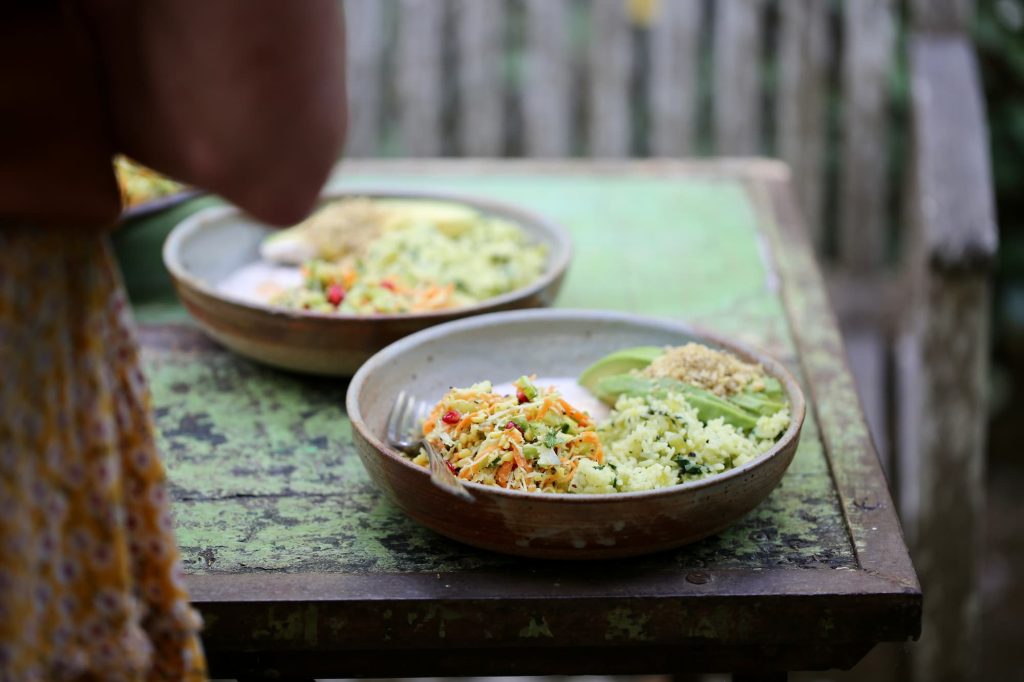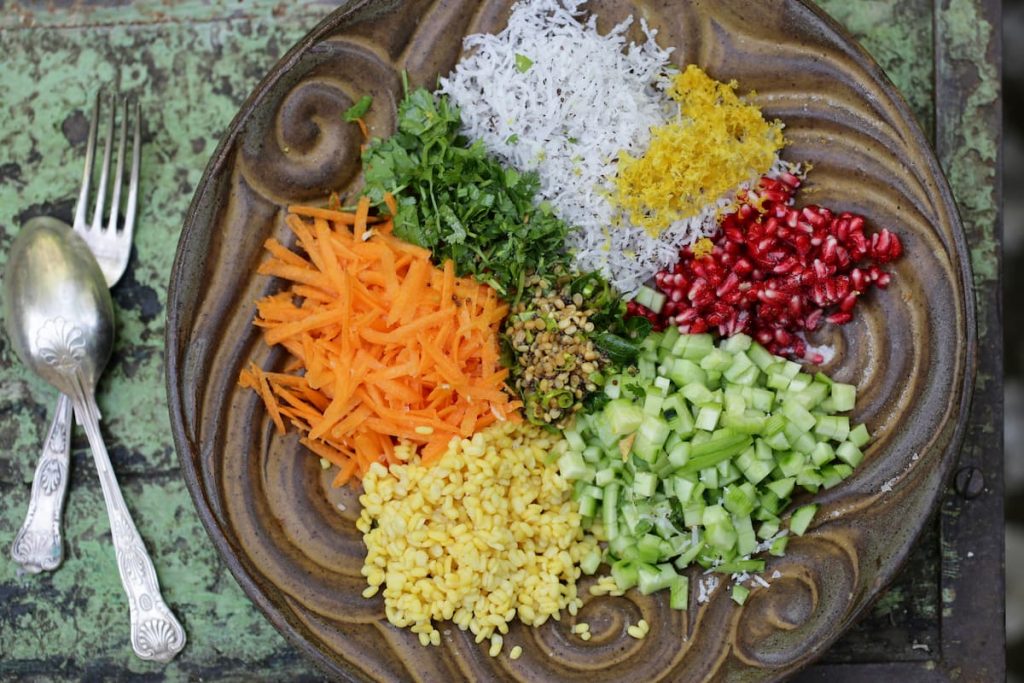
When I’m in India, cosamberi becomes my go-to fresh salad. I enjoy starting my first meal with something crunchy and refreshing. In Portugal, that often means a mix of salad greens or crisp root vegetables from the garden. In India, where tender salad leaves are harder to come by, this simple combination of raw grated carrot and/or chopped cucumber, soaked moong dal, fresh coconut, and a crunchy voggarane (tempering) perfectly satisfies that craving.
two things really make cosamberi shine
The sweetness of freshly grated coconut and the final tempering of spices with a scattering of dal add a delightful crunch to every bite. The only plan-ahead step is soaking the moong dal and grating the coconut — but both can be done while other dishes are simmering away.
what do you serve with cosamberi?
Cosamberi pairs beautifully with lemon rice — I especially love it with green pepper for a subtle twist, alongside creamy avocado topped with a tomato–mustard seed salsa. It’s also lovely served with celery saffron rice with a drizzle of tahini sauce, slices of avocado with a sprinkle of pine nut parmesan as in the photo.
tips for perfect cosamberi
cucumber preparation: Avoid grating cucumber, as it releases too much water. For mini cucumbers, simply chop with the skin on. For large cucumbers, peel the skin, remove seeds, and chop before using.
soaking moong dal: Soak moong dal in hot water for about 1 hour, until it reaches the soft-press stage — tender yet retaining a slight crunch. Avoid substituting with other dals, as this will alter the texture, digestibility, and subtle energetic qualities of the dish.
fresh coconut: One of the main highlights of this South Indian salad is the fresh coconut, which adds both texture and earthiness.
freezing coconut: Leftover grated coconut can be sealed in an airtight container and stored in the freezer.
substitute option: If fresh coconut is unavailable, use ½ cup (35 g) dried shredded coconut instead.
grating tip: For the best texture, grate coconut finely using the fine side of a box grater.

cosamberi
serves: 3–4 as a side dish
pre-preparation: 1 hour
preparation: 15 minutes
Adapted from our teacher, Ganapati Aarya, who shared this recipe as part of the Jivana Yoga Program Ayurvedic recipes.
ingredients for salad
¼ cup/50g split moong dal
1 heaped cup/80 g grated fresh coconut
¼ cup/40g pomegranate arils
1 large carrot (about 100g)
1–2 small cucumbers, (about 120g) chopped into small pieces
1 Tbsp + 2 tsp/25 ml lemon juice, divided
zest from one lemon
⅓ cup/15 g coriander leaves, finely chopped
½ tsp fine rock salt
voggarane (tempering)
2 Tbsp + 1 tsp peanut or coconut oil
½ heaped tsp mustard seeds
1 heaped tsp split urad dal
1 green chilli, seeds removed and finely chopped
15 fresh curry leaves
⅛ tsp asafoetida powder
⅛ heaped tsp turmeric powder
pre-preparation
- Rinse moong dal well, then soak for 1 hour.
- Drain and allow to dry for 15 minutes.
preparation
- Grate the fresh coconut (measure 1 cup).
- Peel, and grate the carrot (measure 1 cup). Toss with 1 tsp lemon juice to prevent discolouration.
- Peel and finely chop the cucumber.
- In a mixing bowl, combine moong dal, coconut, carrot, cucumber, pomegranate, and coriander. Sprinkle with salt—do not mix yet.
voggarane
- Heat oil in a small pan. Add mustard seeds; when they turn grey and pop, add the urad dal and chilli. Fry until the dal is golden-brown.
- Add curry leaves, asafoetida, and turmeric; fry for a few seconds, swishing the pan to ensure even cooking.
- Pour the voggarane over the salad, add the remaining lemon juice, and mix well so colours and flavours blend evenly.
For my birthday, my husband gifted me a family of peacocks. Their presence fills each day with colour and joy. In Indian tradition, the peacock is a symbol of beauty, grace, and divine connection—their call is said to lift the heart toward higher states of happiness.
Goodness shared from Stacey










